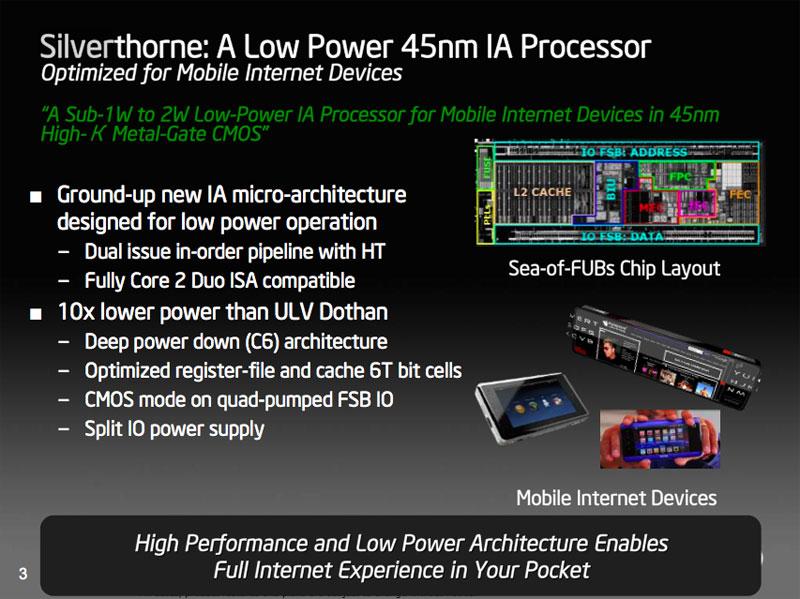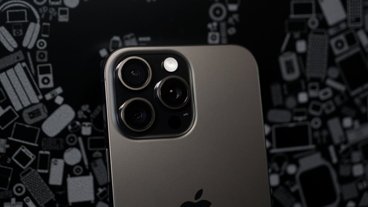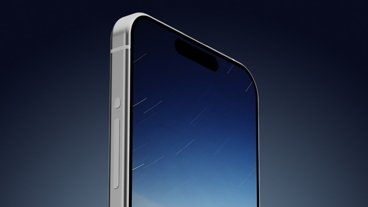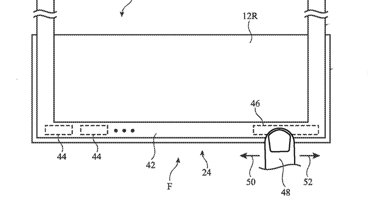Presenting at the Solid State Circuits Conference (ISSCC) in San Francisco this week, the world's largest chipmaker issued 15 technical papers covering some of its most recent advancements. Atop that list is Silverthone, the code-name for the company's forthcoming 45 nanometer high-k metal gate, low-power processor architecture for ultra-mobile and mobile Internet devices.
Intel says the microarchitecture will be fully compatible with the Core 2 Duo instruction set, meaning Silverthorne chips will be capable of running the same applications written for Core 2 Duo-based notebook PCs.
At their peak, chips running on the new architecture will deliver performance inline with that of the Pentium M chips that powered the first array of Centrino notebooks, but consume only between 0.5 and 2 watts — about 10 times less than a typical notebook chip.
Silverthorne processors will also boast support for a low power mode and hyperthreading, according to Intel. The first will allow the chips to shut down between tasks for optimal power savings, while the second will allow for execution of multiple simultaneous threads on a single core — essentially emulating a dual-core chip.
Thus far, no specific chip numbers or clock frequencies have been released by Intel, though the firm maintains that the first production quality units should arrive some time during the second quarter of the year, with successive models eventually scaling up to 2.0GHz.
Intel chief executive Paul Otellini has already gone on record in saying that his firm plans a whole "product family" of 45 nm Silverthorne chips in the near future aimed at capturing the "top 10 to 20 percent of the cellphone market.â€
Chief among the players aiding Intel on its quest for a slice of the high-end cell phone market is Apple, which AppleInsider reported in December would be among the first electronics makers to adopt Silverthorne chips.
 Katie Marsal
Katie Marsal








 Charles Martin
Charles Martin
 Marko Zivkovic
Marko Zivkovic
 Andrew Orr
Andrew Orr
 Amber Neely
Amber Neely

 William Gallagher and Mike Wuerthele
William Gallagher and Mike Wuerthele











74 Comments
How do these compare to ARM power consumption? I thought ARM used quite a but less. If it does then these aren't a good candidate for iDevices.
Um, there isn't much food on this dish. Nothing in fact. There isn't anything new here. I'd like to know say: 1 GHz Silverthorne = ?.? GHz Core 2 Duo at ?? Watts TDP; or, 1.8 GHz Silverthorne = ?.? Core 2 Duo at ?? Watt TDP. This will be new information.
Ie, if we put a 1.8 GHz Silverthorne into a MBA, will it be equivalent to the 1.8 GHz Core 2 Duo (highly unlikely). Will it be like a 1.2 GHz Core 2 Duo, but will have double/triple the battery life?
One Silverthorne iPhone with GPS and 32 GB storage, please!
Also please implement Intel's new "widejack" headphone interface technology
Not to reiterate the poster above but more info is required! Like what is the overall power draw of the chip set at a specific speed and performance level. Also what are the different variants and how do they accommodate the various radio hardware required.
As to ARM, I just don't see how Apple is going to be able to jam a Silverthorne into an iPhone. Especially considering that ARM aligned companies have dual core SOC implementations in the wings.
Now Newton 2 that is another matter. I could also see a bigger iPod to better deliver multimedia. Things do look good for Apple and Intel!
Heck if Apple put one in an AIR like portable and added the missing I/O I might even be interested.
Dave
Um, there isn't much food on this dish. Nothing in fact. There isn't anything new here. I'd like to know say: 1 GHz Silverthorne = ?.? GHz Core 2 Duo at ?? Watts TDP; or, 1.8 GHz Silverthorne = ?.? Core 2 Duo at ?? Watt TDP. This will be new information.
Ie, if we put a 1.8 GHz Silverthorne into a MBA, will it be equivalent to the 1.8 GHz Core 2 Duo (highly unlikely). Will it be like a 1.2 GHz Core 2 Duo, but will have double/triple the battery life?
you're asking the wrong questions.
Intel has clearly said that these were for small mobile devices, not notebooks, even ultralights.
Perhaps, several years down the line, they may be powerefull enough for that purpose, but then, more standard power consumption chips will also have become more powerful.
The MD Air has what would have been considered to be a very powerful cpu three years ago, but today, it is the least powerful machine in Apple's lineup.
The same thing will be true in the future. People want more powerful machines.
But for the less demanding handheld device market, these will work well.